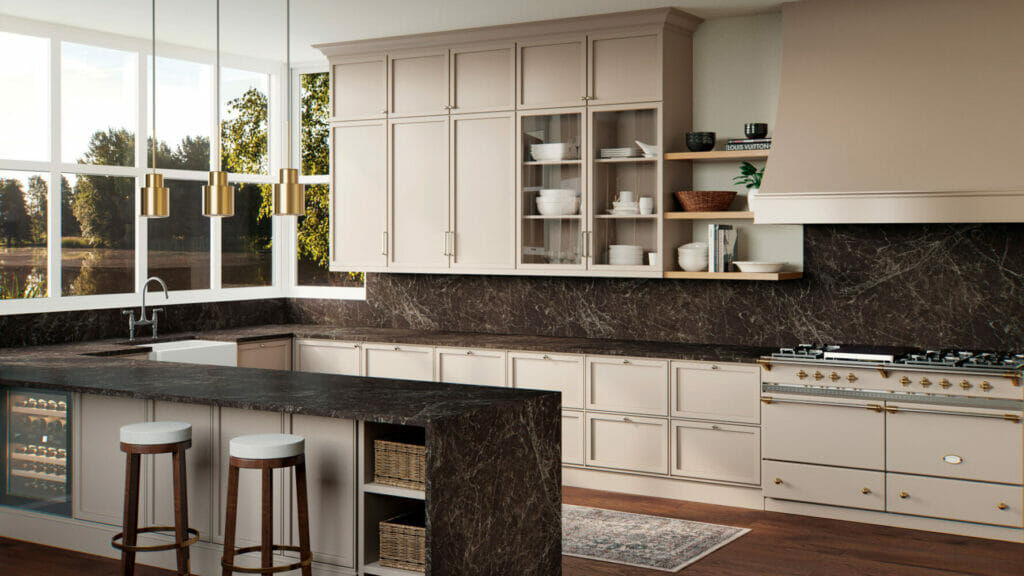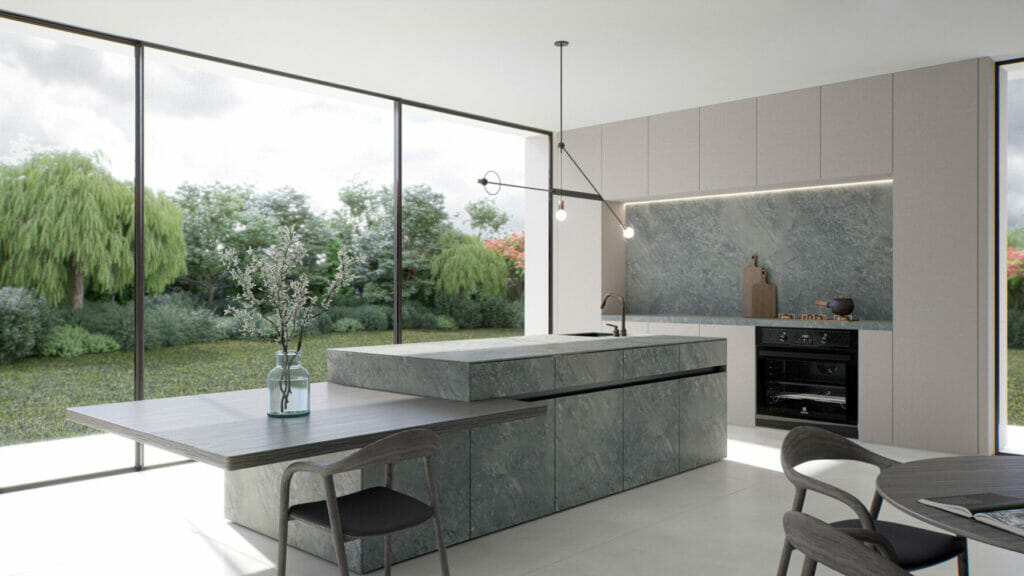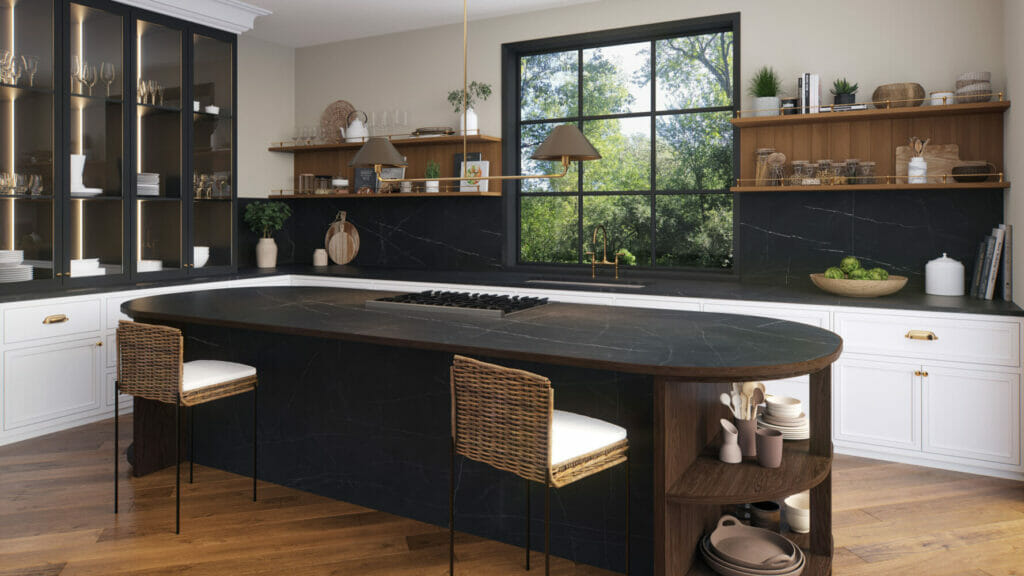Porcelain Kitchen Countertops: Design Ideas
6 min read
Porcelain is a material that has been well utilized for several years in everything from tableware to decor. But in recent years, it’s found a new application in homes in the form of kitchen countertops.
Thanks to its modern aesthetic, appearance and functionality, porcelain is becoming an increasingly popular choice for homeowners and interior designers. It’s made of China clay, also called Kaolin clay, which helps give the material its strong build.
Kaolin is mixed and homogenized with other materials in high temperatures (1450 °C) to create porcelain, which includes a mix of quartz, clay and feldspar.
The result is a durable countertop material with several properties that make it ideal for kitchen applications. Porcelain is known to be resistant to heat, chips, stains, and scratches, making it suitable for areas that see high use.
Additionally, porcelain can be customized with different designs, colours, and cuts, which gives homeowners more freedom to explore their creativity and find a countertop that suits their style and vision for their kitchens.

Here are some design ideas that homeowners can use in their kitchens:
White is among the most common colours used for porcelain tile kitchen countertops, and it’s no surprise why that’s the case. White is easy to integrate into a kitchen and gives homeowners the opportunity to add contrast to the space by utilizing bold colours.
For instance, homeowners that want to install a white porcelain countertop in a kitchen can add a splash of contrast to the space by pairing it with deep brown cabinetry and a bold red backsplash.
Porcelain countertops can be enhanced with interesting edge profiles. The waterfall edge is a good choice for porcelain counters — and with an integrated sink, it creates a stunning focal point for any kitchen.
Porcelain is highly versatile and customizable, and homeowners should take advantage of those characteristics by going for unique patterns. Whether a white porcelain countertop features grey veining, subtle specks, or gold outlines, the seemingly small details can make a porcelain countertop more interesting and unique.
Unlike other countertop materials, homeowners can go as big as they want with kitchen porcelain slabs without worrying about a seam in the middle. Porcelain can be cut into large slabs and installed as one piece, which relieves those who want their countertops to match their large kitchens.
A porcelain countertop does not have to be a boring, rectangular surface. Homeowners can play around with cuts to create a distinctive design that’s uniquely theirs.
Porcelain can even resemble natural stone, for those who want to take advantage of porcelain’s benefits but like the aesthetic of other materials.

Porcelain is a very versatile material that is perfect for kitchen countertops, but before homeowners can commit to it, they should weigh its pros and cons.
As mentioned, porcelain is a highly durable material that’s resistant to chipping, breaking, and early wear and tear. It can withstand impact and regular use, making it a reliable option for countertops that will retain their appearance and functionality over time. Additionally, porcelain is highly resistant to heat and fading, even when exposed to harsh sunlight or hot pans and pots.
Porcelain is easy to maintain, only requiring homeowners to wipe the surface with a damp cloth and soapy water. Stains can be removed without extensive scrubbing, due to the material’s porosity.
Porcelain, being man-made, can be cut into larger sizes, eliminating grout lines and seams that ruin a countertop’s aesthetic appeal.
The only real disadvantage of porcelain is its price. It tends to be more expensive than other countertop materials, but many homeowners find that the pros make the investment worthwhile.
Ultimately, before buying porcelain, homeowners should know what to look out for and, of course, determine their personal style. Since there are many colours, patterns, and designs to choose from, taking a style quiz can help homeowners find the perfect slab of porcelain for their kitchens.
A porcelain kitchen countertop is very durable because of its makeup. Porcelain is made to be thick, robust, and durable, utilizing high-quality ingredients that are combined under extreme temperatures. Its strength is unmatched by other countertop materials, making it perfect for rigorous daily use.
Porcelain has a lot of properties that make it a durable choice for kitchen countertops, some of which include:
Because porcelain is manufactured under extreme temperatures, it is also heat-resistant. This means homeowners can place hot pans and pots directly on the surface, but for maximum longevity, the use of trivets or hot pads is still recommended.
Porcelain does not react to acidic liquids and substances, meaning that it won’t lose its colour or fade if it comes into contact with vinegar, wine, lemons, tomatoes, etc.
Even light-coloured porcelain will not stain, which is great news for homeowners concerned about guests spilling their wine or coffee on their surface. Because it is non-porous and doesn’t absorb any liquid, spills can be easily wiped down without worrying about damaging the countertop.
Some countertop materials, such as natural stone, cannot be exposed to too much sunlight. Otherwise, the UV rays will cause the colours to fade. Porcelain, however, is more resistant to sun exposure; it doesn’t discolour even with constant exposure to sunlight.
Porcelain is a strong material that is known to resist scratches. Homeowners can cut directly on their porcelain kitchen countertops, though Caesarstone still recommends using a cutting board.
When a material is non-porous, it means that air and liquid cannot move through it. This feature is one of the most attractive aspects of porcelain kitchen countertops, as it contributes to its stain resistance. Being non-porous makes porcelain a suitable countertop material for areas with a lot of moisture, such as kitchens or bathrooms.

Porcelain is finding broader application in kitchens—and because of its favourable characteristics and customizability, there’s no doubt as to why. Homeowners should put porcelain high up on their list of countertop material options, and as long as they get creative, they can create a luxurious focal point for their kitchens.
Homeowners can click the following link to order a sample of different colours, patterns, and styles to find the perfect product for their space.
{{ subtitle }}
{{ i.desc }}
{{ subtitle }}
{{ subtitle }}